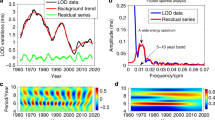Summary
¶Evidence is presented for a previously unknown climate cycle of 30,000 yr period. The cycle is deemed to be related to the gyroscopic precession, or wobble of the Earth axis. Since it inhibits glaciation, the 30,000 yr cycle is called the summer cycle while its counterpart, the 22,000 yr “precession” cycle, is the winter cycle. Because of the aspect presented to the Sun, summer is effectively longer than winter. This is used to explain the difference between summer and winter cycle periods and that of the wobble. Some of the problems encountered in interpreting oxygen ratio glaciation data are resolved by knowledge of the existence of the summer cycle and a means is devised for determining the relative volume of glacial ice. An argument is made that essentially eliminates the 100,000 yr-orbit cycle, by itself or in combination with other attitude cycles, as a possible cause of the glacial/interglacial cycles.
Similar content being viewed by others
Author information
Authors and Affiliations
Additional information
Received August 17, 2002; accepted September 3, 2002
Rights and permissions
About this article
Cite this article
Bell, L. A 30,000 yr precession-related cycle affecting climate. Theor. Appl. Climatol. 74, 245–253 (2003). https://doi.org/10.1007/s00704-002-0711-7
Issue Date:
DOI: https://doi.org/10.1007/s00704-002-0711-7




